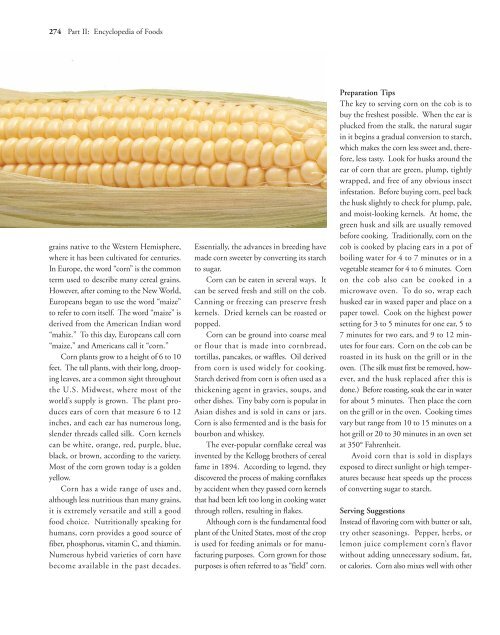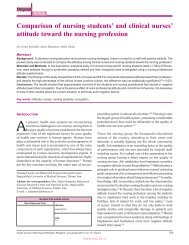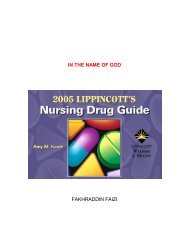- Page 2 and 3:
ENCYCLOPEDIAof FOODSa guide to Heal
- Page 4 and 5:
ENCYCLOPEDIAof FOODSa guide to Heal
- Page 6 and 7:
ForewordIbelieve that knowledge is
- Page 8 and 9:
Chapter 5 Preparing Healthful Meals
- Page 10 and 11:
published in the area of nutrition.
- Page 12 and 13:
contributions are worthy of special
- Page 14 and 15:
2 Chapter 2A GUIDE TOHEALTHYNUTRITI
- Page 16 and 17:
The Nutriants and Other Food Substa
- Page 18 and 19:
C H A P T E r o n eOPTIMIZINGHEALTH
- Page 21 and 22:
8 Part I: A Guide to Healthy Nutrit
- Page 23 and 24:
10 Part I: A Guide to Healthy Nutri
- Page 25 and 26:
12 Part I: A Guide to Healthy Nutri
- Page 27 and 28:
14 Part I: A Guide to Healthy Nutri
- Page 29 and 30:
In this chapter, you will be introd
- Page 31 and 32:
18 Part I: A Guide to Healthy Nutri
- Page 33 and 34:
20 Part I: A Guide to Healthy Nutri
- Page 35 and 36:
22 Part I: A Guide to Healthy Nutri
- Page 37:
24 Part I: A Guide to Healthy Nutri
- Page 40 and 41:
Chapter 2: The Nutrients and Other
- Page 43 and 44:
30 Part I: A Guide to Healthy Nutri
- Page 45 and 46:
32 Part I: A Guide to Healthy Nutri
- Page 47 and 48:
34 Part I: A Guide to Healthy Nutri
- Page 49 and 50:
36 Part I: A Guide to Healthy Nutri
- Page 51 and 52:
38 Part I: A Guide to Healthy Nutri
- Page 54 and 55:
Chapter 2: The Nutrients and Other
- Page 56 and 57:
Chapter 2: The Nutrients and Other
- Page 58 and 59:
Chapter 2: The Nutrients and Other
- Page 60 and 61:
C H A P T E r t h r e eTHEFOOD-HEAL
- Page 62 and 63:
Chapter 3: The Food-Health Connecti
- Page 64 and 65:
Chapter 3: The Food-Health Connecti
- Page 66 and 67:
Chapter 3: The Food-Health Connecti
- Page 68 and 69:
Chapter 3: The Food-Health Connecti
- Page 70 and 71:
Chapter 3: The Food-Health Connecti
- Page 72 and 73:
Chapter 3: The Food-Health Connecti
- Page 74 and 75:
Chapter 3: The Food-Health Connecti
- Page 76 and 77:
Chapter 3: The Food-Health Connecti
- Page 78 and 79:
Chapter 3: The Food-Health Connecti
- Page 80 and 81:
Chapter 3: The Food-Health Connecti
- Page 82 and 83:
Chapter 3: The Food-Health Connecti
- Page 84 and 85:
Chapter 3: The Food-Health Connecti
- Page 86 and 87:
Chapter 3: The Food-Health Connecti
- Page 88 and 89:
Chapter 3: The Food-Health Connecti
- Page 90 and 91:
Chapter 3: The Food-Health Connecti
- Page 92 and 93:
C H A P T E r f o u rPLANNINGMEALSS
- Page 94 and 95:
Chapter 4: Planning Meals 81which a
- Page 96 and 97:
Chapter 4: Planning Meals 83how man
- Page 98 and 99:
Chapter 4: Planning Meals 85flavore
- Page 100 and 101:
Chapter 4: Planning Meals 87and if
- Page 102 and 103:
Chapter 4: Planning Meals 89saturat
- Page 104 and 105:
Chapter 4: Planning Meals 91(Genera
- Page 106 and 107:
Chapter 4: Planning Meals 93HEALTH
- Page 108 and 109:
Chapter 4: Planning Meals 95Two Wee
- Page 110 and 111:
Chapter 4 : Planning Meals 97
- Page 112 and 113:
Chapter 4: Planning Meals 99Breakfa
- Page 114 and 115:
Chapter 4 : Planning Meals 101
- Page 116 and 117:
Chapter 4: Planning Meals 103Breakf
- Page 118 and 119:
Chapter 4 : Planning Meals 105
- Page 120 and 121:
Chapter 4: Planning Meals 107Breakf
- Page 122 and 123:
Chapter 4 : Planning Meals 109
- Page 124 and 125:
Chapter 4: Planning Meals 111Breakf
- Page 126 and 127:
Chapter 4 : Planning Meals 113
- Page 128 and 129:
Chapter 4: Planning Meals 115day 10
- Page 130 and 131:
Chapter 4 : Planning Meals 117
- Page 132 and 133:
Chapter 4: Planning Meals 119day 12
- Page 134 and 135:
Chapter 4 : Planning Meals 121
- Page 136 and 137:
Chapter 4: Planning Meals 123day 14
- Page 138 and 139:
C H A P T E r f i v ePREPARINGHEALT
- Page 140 and 141:
Chapter 5: Preparing Healthful Meal
- Page 142 and 143:
Chapter 5: Preparing Healthful Meal
- Page 144 and 145:
Chapter 5: Preparing Healthful Meal
- Page 146 and 147:
Chapter 5: Preparing Healthful Meal
- Page 148 and 149:
Chapter 5: Preparing Healthful Meal
- Page 150 and 151:
Chapter 5: Preparing Healthful Meal
- Page 152 and 153:
Chapter 5: Preparing Healthful Meal
- Page 154 and 155:
Chapter 5: Preparing Healthful Meal
- Page 156 and 157:
Chapter 5: Preparing Healthful Meal
- Page 158 and 159:
Chapter 5: Preparing Healthful Meal
- Page 160 and 161:
Chapter 5: Preparing Healthful Meal
- Page 162 and 163:
Chapter 5: Preparing Healthful Meal
- Page 164 and 165:
P a r t I IPart I of this book revi
- Page 166 and 167:
153FruitsOur earliest ancestors bui
- Page 168 and 169:
Fruits 155AppleThe apple is a pome,
- Page 170 and 171:
Fruits 157AvocadoThe avocado is a p
- Page 172 and 173:
Fruits 159BerriesBerry is a general
- Page 174 and 175:
Fruits 161taste, they must be combi
- Page 176 and 177:
Fruits 163MulberryFamily MoraceaeSc
- Page 178 and 179:
Fruits 165SERVINGSIZE:1/2 cupNutrie
- Page 180 and 181:
Fruits 167CALAMONDINCalamondin, als
- Page 182 and 183:
Fruits 169CherimoyaThe cherimoya is
- Page 184 and 185:
Fruits 171CoconutThe coconut is the
- Page 186 and 187:
Fruits 173DurianThe durian varies f
- Page 188 and 189:
Fruits 175FigThe fig is a pleasantl
- Page 190 and 191:
Fruits 177GrapesMore grapes are gro
- Page 192 and 193:
Fruits 179JackfruitThe jackfruit is
- Page 194 and 195:
Fruits 181KiwiThe kiwi is a small f
- Page 196 and 197:
Fruits 183LemonThe lemon is a small
- Page 198 and 199:
Fruits 185LONGANThe longan is a sma
- Page 200 and 201:
Fruits 187LycheeThe lychee is a sma
- Page 202 and 203:
Fruits 189MelonsMelons, sweet-flavo
- Page 204 and 205:
Fruits 191NectarineNectarines, ofte
- Page 206 and 207:
Fruits 193OrangeThe orange is a red
- Page 208 and 209:
Fruits 195Passion FruitShaped like
- Page 210 and 211:
Fruits 197PearPears are bell-shaped
- Page 212 and 213:
Fruits 199PineappleThe pineapple is
- Page 214 and 215:
Fruits 201POMEGRANATEThe pomegranat
- Page 216 and 217:
Fruits 203PummeloThe pummelo is a p
- Page 218 and 219:
Fruits 205RAMBUTANThe rambutan is a
- Page 220 and 221:
Fruits 207SAPODILLAThe sapodilla is
- Page 222:
Fruits 209TangerineThe tangerine is
- Page 225 and 226:
212 Part II: Encyclopedia of FoodsA
- Page 227 and 228:
214 Part II: Encyclopedia of FoodsA
- Page 229 and 230:
216 Part II: Encyclopedia of FoodsB
- Page 231 and 232:
218 Part II: Encyclopedia of FoodsB
- Page 233 and 234:
220 Part II: Encyclopedia of FoodsB
- Page 235 and 236: 222 Part II: Encyclopedia of FoodsC
- Page 237 and 238: 224 Part II: Encyclopedia of FoodsC
- Page 239 and 240: 226 Part II: Encyclopedia of FoodsC
- Page 241 and 242: 228 Part II: Encyclopedia of FoodsC
- Page 243 and 244: 230 Part II: Encyclopedia of FoodsC
- Page 245 and 246: 232 Part II: Encyclopedia of FoodsC
- Page 247 and 248: 234 Part II: Encyclopedia of FoodsE
- Page 249 and 250: 236 Part II: Encyclopedia of FoodsG
- Page 251 and 252: 238 Part II: Encyclopedia of FoodsH
- Page 253 and 254: 240 Part II: Encyclopedia of FoodsJ
- Page 255 and 256: 242 Part II: Encyclopedia of FoodsK
- Page 257 and 258: 244 Part II: Encyclopedia of FoodsL
- Page 259 and 260: 246 Part II: Encyclopedia of FoodsO
- Page 261 and 262: 248 Part II: Encyclopedia of FoodsP
- Page 263 and 264: 250 Part II: Encyclopedia of FoodsP
- Page 265 and 266: 252 Part II: Encyclopedia of FoodsP
- Page 267 and 268: 254 Part II: Encyclopedia of FoodsR
- Page 269 and 270: 256 Part II: Encyclopedia of FoodsS
- Page 271 and 272: 258 Part II: Encyclopedia of FoodsS
- Page 273 and 274: 260 Part II: Encyclopedia of Foodsd
- Page 275 and 276: 262 Part II: Encyclopedia of FoodsT
- Page 277 and 278: 264 Part II: Encyclopedia of FoodsT
- Page 279 and 280: 266 Encyclopedia of FoodsWater Ches
- Page 282 and 283: 269GrainsIncludes: Bread, Cereals,
- Page 284 and 285: Grains 271are just beginning to exp
- Page 288 and 289: Grains 275vegetables. Popped corn (
- Page 290 and 291: Grains 277flattened into flakes to
- Page 292 and 293: Grains 279cooked by adding it to li
- Page 294 and 295: Grains 281Wheat also is classified
- Page 296 and 297: Grains 283yeast. When yeast ferment
- Page 298 and 299: Grains 285whole-grain flour has bee
- Page 300 and 301: Grains 287the label to see whether
- Page 302: Grains 289Pasta that is curved or t
- Page 305 and 306: 292 Part II: Encyclopedia of FoodsN
- Page 307 and 308: 294 Part II: Encyclopedia of FoodsD
- Page 309 and 310: 296 Part II: Encyclopedia of FoodsT
- Page 311 and 312: 298 Part II: Encyclopedia of FoodsM
- Page 313 and 314: 300 Part II: Encyclopedia of Foodsa
- Page 315 and 316: 302 Part II: Encyclopedia of Foodst
- Page 317 and 318: 304 Part II: Encyclopedia of Foodsi
- Page 319 and 320: 306 Part II: Encyclopedia of FoodsJ
- Page 321 and 322: 308 Part II: Encyclopedia of FoodsW
- Page 323 and 324: 310 Part II: Encyclopedia of FoodsF
- Page 325 and 326: 312 Part II: Encyclopedia of FoodsA
- Page 327 and 328: 314 Part II: Encyclopedia of FoodsS
- Page 329 and 330: 316 Part II: Encyclopedia of FoodsP
- Page 331 and 332: 318 Part II: Encyclopedia of FoodsS
- Page 333 and 334: 320 Part II: Encyclopedia of Foodsc
- Page 335 and 336: 322 Part II: Encyclopedia of Foodss
- Page 337 and 338:
324 Part II: Encyclopedia of FoodsS
- Page 339 and 340:
326 Part II: Encyclopedia of FoodsS
- Page 341 and 342:
328 Part II: Encyclopedia of FoodsS
- Page 343 and 344:
330 Part II: Encyclopedia of FoodsL
- Page 345 and 346:
332 Part II: Encyclopedia of FoodsP
- Page 347 and 348:
334 Part II: Encyclopedia of FoodsN
- Page 349 and 350:
336 Part II: Encyclopedia of FoodsB
- Page 351 and 352:
338 Part II: Encyclopedia of Foodsw
- Page 353 and 354:
340 Part II: Encyclopedia of FoodsP
- Page 355:
342 Part II: Encyclopedia of FoodsT
- Page 358 and 359:
345Dairy FoodsIncludes: Milk, Yogur
- Page 360 and 361:
Dairy Foods 347LACTOSE INTOLERANCEA
- Page 362 and 363:
Dairy Foods 349MILK ALLERGY: HIDDEN
- Page 364 and 365:
Dairy Foods 351of dried milk keep b
- Page 366 and 367:
Dairy Foods 353Serving SuggestionsA
- Page 368 and 369:
Dairy Foods 355pressed out of it. I
- Page 370 and 371:
Dairy Foods 357Colby — A blander,
- Page 372 and 373:
Dairy Foods 359yogurt can be a chal
- Page 374:
Dairy Foods 361FAVORITE FLAVORWhat
- Page 377 and 378:
364 Part II: Encyclopedia of Foodsb
- Page 379 and 380:
366 Part II: Encyclopedia of Foodsf
- Page 381 and 382:
368 Part II: Encyclopedia of FoodsH
- Page 383 and 384:
370 Part II: Encyclopedia of FoodsC
- Page 385 and 386:
372 Part II: Encyclopedia of FoodsF
- Page 387 and 388:
374 Part II: Encyclopedia of Foodsr
- Page 390 and 391:
377BeveragesBeverages are used to q
- Page 392 and 393:
Beverages 379SAFETY OF TAP WATERMan
- Page 394 and 395:
Beverages 381At home, store coffee
- Page 396 and 397:
Beverages 383TEAS AND POSSIBLE HEAL
- Page 398 and 399:
Beverages 385The flavor of sparklin
- Page 400 and 401:
Beverages 387ALCOHOL AND HEALTHHeav
- Page 402 and 403:
389Fats, Oils, & SweetenersIf there
- Page 404 and 405:
Fats, Oils, & Sweeteners 391FatsBut
- Page 406 and 407:
Fats, Oils, & Sweeteners 393Lard is
- Page 408 and 409:
Fats, Oils, & Sweeteners 395One of
- Page 410 and 411:
Fats, Oils, & Sweeteners 397Peanuts
- Page 412 and 413:
Fats, Oils, & Sweeteners 399oils in
- Page 414 and 415:
Fats, Oils, & Sweeteners 401of regu
- Page 416 and 417:
Fats, Oils, & Sweeteners 403HONEY A
- Page 418 and 419:
Fats, Oils, & Sweeteners 405months.
- Page 420 and 421:
GlossaryAcute: Term used to describ
- Page 422 and 423:
Glossary 409Diarrhea: An increase i
- Page 424 and 425:
Glossary 411Infarct: An area of tis
- Page 426 and 427:
Glossary 413-oma: Suffix meaning
- Page 428 and 429:
Glossary 415Thyroid gland: The endo
- Page 430 and 431:
eading listAmerican Diabetes Associ
- Page 432 and 433:
Reading List 419National Institute
- Page 434 and 435:
APPENDIXDIETARY REFERENCE INTAKESAN
- Page 436 and 437:
Dietary Reference Intakes 423Niacin
- Page 438 and 439:
Dietary Reference Intakes 425Magnes
- Page 440 and 441:
Dietary Reference Intakes 427Niacin
- Page 442 and 443:
Dietary Reference Intakes 429Magnes
- Page 444 and 445:
Vitamins 431Riboflavin (B 2)Men:19
- Page 446 and 447:
Minerals 433IronMen:19 years or old
- Page 448 and 449:
Nutrients in Foods 435Potassium (mg
- Page 450 and 451:
Nutrients in Foods 437Potassium (mg
- Page 452 and 453:
Nutrients in Foods 439Sodium (mg)Zi
- Page 454 and 455:
Nutrients in Foods 441Sodium (mg)Zi
- Page 456 and 457:
Nutrients in Foods 443Sodium (mg)Zi
- Page 458 and 459:
Nutrients in Foods 445Sodium (mg)Zi
- Page 460 and 461:
Nutrients in Foods 447Sodium (mg)Zi
- Page 462 and 463:
Nutrients in Foods 449Sodium (mg)Zi
- Page 464 and 465:
Nutrients in Foods 451Sodium (mg)Zi
- Page 466 and 467:
Nutrients in Foods 453Sodium (mg)Zi
- Page 468 and 469:
Nutrients in Foods 455Sodium (mg)Zi
- Page 470 and 471:
Nutrients in Foods 457Sodium (mg)Zi
- Page 472 and 473:
Nutrients in Foods 459Sodium (mg)Zi
- Page 474 and 475:
Nutrients in Foods 461Sodium (mg)Zi
- Page 476 and 477:
Nutrients in Foods 463Sodium (mg)Zi
- Page 478 and 479:
Nutrients in Foods 465Sodium (mg)Zi
- Page 480 and 481:
Nutrients in Foods 467Sodium (mg)Zi
- Page 482 and 483:
Nutrients in Foods 469Sodium (mg)Zi
- Page 484 and 485:
Nutrients in Foods 471Sodium (mg)Zi
- Page 486 and 487:
Nutrients in Foods 473Sodium (mg)Zi
- Page 488 and 489:
Nutrients in Foods 475Sodium (mg)Zi
- Page 490 and 491:
Nutrients in Foods 477Zinc (mg)Copp
- Page 492 and 493:
Nutrients in Foods 479Zinc (mg)Copp
- Page 494 and 495:
Nutrients in Foods 481Sodium (mg)Zi
- Page 496 and 497:
Nutrients in Foods 483Zinc (mg)Copp
- Page 498 and 499:
GlyciteinTotal isoflavonesXXXTerpen
- Page 500 and 501:
GlyciteinTotal isoflavonesX XXXXX X
- Page 502 and 503:
GlyciteinTotal isoflavonesTerpenesE
- Page 504 and 505:
GlyciteinTotal isoflavonesTerpenesE
- Page 506 and 507:
0.27 3.61 trace 0.560.74 0 0.82 00.
- Page 508 and 509:
Phytochemicals 495Other phytochemic
- Page 510 and 511:
CreditsTop 10 Causes of Death (U.S.
- Page 512 and 513:
Credits 499How Much Vitamin D Is En
- Page 514 and 515:
IndexAAbalone, 318Acceptable daily
- Page 516 and 517:
Index 503Carica papaya, 194Caroteno
- Page 518 and 519:
Index 505leek, 243onion, 247scallio
- Page 520 and 521:
Index 507loquat, 186lychee, 187mang
- Page 522 and 523:
Index 509Linseed oil, 394Liquid, as
- Page 524 and 525:
Index 511Papaya, 194Paprika, 372-37
- Page 526 and 527:
Index 513hypertension, 54osteoporos
- Page 528 and 529:
Index 515nectarine, 191passion frui















